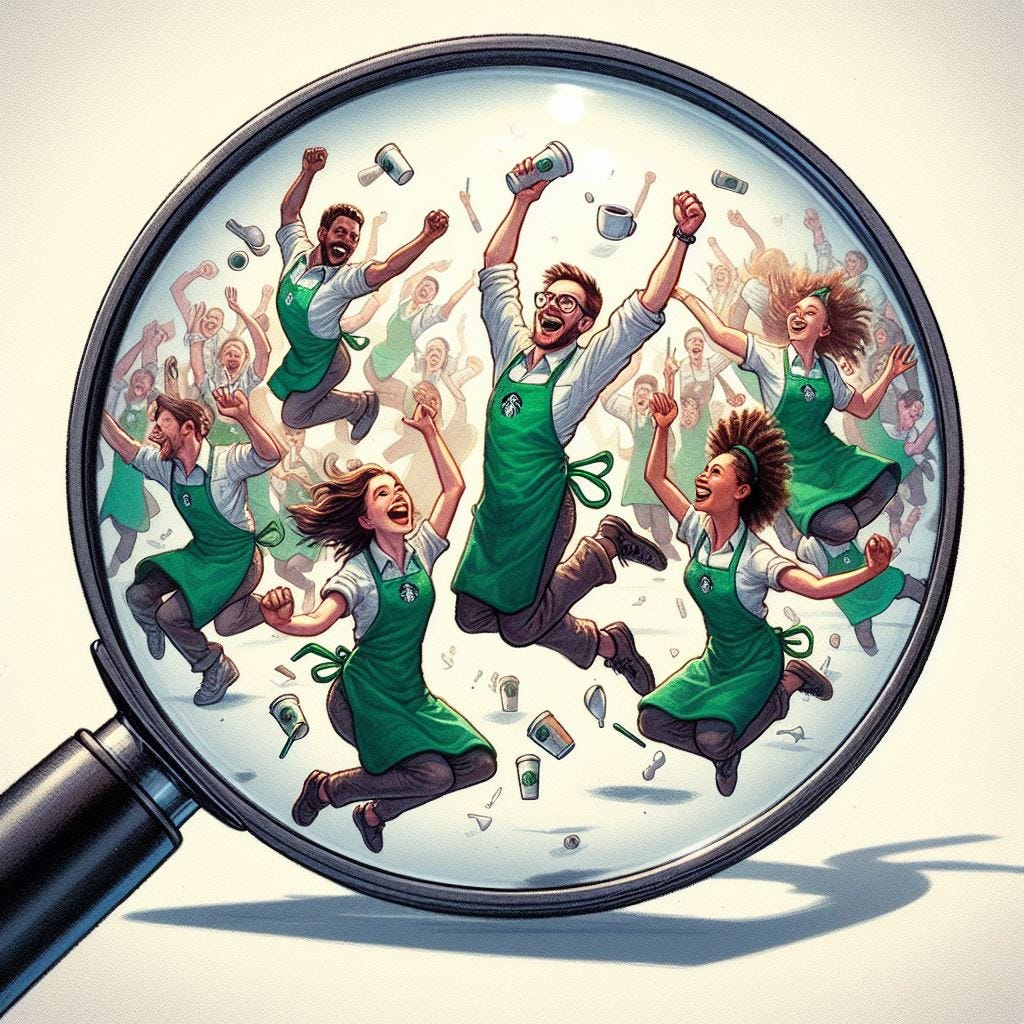Let's take a closer look at the Starbucks "truce" with Workers United
Agreeing to discuss a 'framework' is a long way from the finish line.
Last week, I was contacted by a reporter asking for my opinion about the “truce” that was announced between Starbucks and Workers United early last week.
For whatever reason, the reporter decided against using my comments in the article. So, I’ll share some thoughts here:
First, some background:
As most LaborUnionNews.com readers know, Workers United—an affiliate of the Service Employees International Union (SEIU)—targeted Starbucks in Buffalo, New York in late 2021.
After deploying numerous union salts into the Buffalo region, Workers United successfully argued its case to the National Labor Relations Board (NLRB) that a single-store site was appropriate bargaining unit,” as opposed to a district-wide bargaining unit, which is what Starbucks.argued for [This is relevant to what has occurred since then.]
Since 2021, nearly 400 (out of 9,700) Starbucks-owned stores have become unionized. This means more than 95 percent of Starbucks’ corporate-owned stores are still non-union.
Following the unionization of hundreds of stores, Workers United has attempted to negotiate a nationwide agreements, which Starbucks has, until this week, refused to do.
“From the beginning, Workers United has only filed petitions seeking to represent partners at individual Starbucks stores,” Starbucks stated on its website. “In fact, Starbucks originally sought to have elections on a market-wide or district-wide basis, but Workers United opposed that request, and argued that only single store units were appropriate.”
Over the following two years, according to Bloomberg, the NLRB’s General Counsel has filed more than 100 charges against Starbucks.
To date, despite charges back and forth by the union and company alleging a refual to bargain, there has not been a single contract reached for any of the 400 stores.
Since the union’s campaign against Starbucks began, Workers United has engaged in what is commonly referred to as a “corporate campaign,” which has consisted of numerous one-day strikes, rallies, a bus tour, media releases, shareholder activism and more.
A War of Attrition:
Although the union’s battle with Starbucks has not significantly impacted its stock price, nor has it impacted revenues—Starbucks revenue for the twelve months ending December 31, 2023 was $36.687B, a 11.46% increase year-over-year—it had become clear that, to most observers, the union’s battle with Starbucks had become a “war of attrition,” with no end in sight.
Following the third departure of Starbucks’ CEO Howard Schultz, Starbucks new leadership notified the union in December that the company wanted to resume bargaining.
Perhaps it was due to a change in leadership, or perhaps it was due to a feeling of ‘it’s time to move on,’ whatever the case, Starbucks appeared to realize that, without some movement, the ‘war of attrition’ would go on indefinitely.
A significant step, but a ‘framework’ for negotiations does not mean a contract
Last week’s announcement that Starbucks and Workers United “have agreed to create a ‘framework’ to guide organizing and collective bargaining and potentially settle scores of pending legal disputes.” is a significant step in possibly getting to a contract.
However, a lot depends on whether the company and union can agree on the terms of the ‘framework,’ let alone agree to an actual contract.
A long way from the finish line. Although Starbucks’ has decided, along with Workers United, to collaborate on developing a framework for bargaining which includes, according to the American Prospect, crafting “a master contract that applies to all unionized outlets, to be augmented, if necessary, by add-on contracts dealing with issues specific to particular outlets,” the proverbial devil is always in the details.
Will a contract, if one can be reached, be an incentive to unionize?
“The breakthrough could quickly lead to a lot more organizing, because it signals that unionizing no longer means missing out on benefits other cafes are receiving, now comes with a better prospect of actually getting a union contract and isn’t counter to the company’s ethos,” Bloomberg’s Josh Eidelson—himself a former union organizer—wrote on Thursday.
Really? It seems as though it is much too soon for that speculation. As noted above, it remains to be seen whether Starbucks and Workers United will be able to agree to a ‘framework’ for bargaining, let alone a full contract.
Additionally, if a contract can be reached with a union that only represents four percent of the company’s employees, it seems a stretch to believe the company would agree to anything more than 95 percent of its non-unionized baristas have.
Labor peace for union dues is a decent tradeoff. If it is, indeed, the case where non-union baristas and union baristas end up with the same wages and benefits, but unionized baristas pay union dues, the only parties that win are Workers United and Starbucks: Workers United gets union dues (along with initiation fees) in perpetuity and Starbucks gets labor peace.
In the end, that’s not a bad tradeoff. However, as I told the reporter last week, they are still a long way from the finish line.





